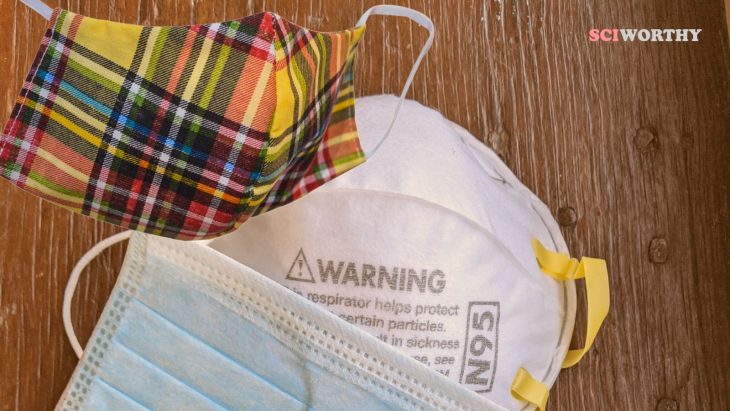SARS-CoV-2, the virus that causes COVID-19, enters our body through our nose and mouth, and therefore, covering your face minimizes the chances of getting infected with coronaviruses. The most commonly used masks are surgical masks and N95/FFP2 masks. But how effective are they?
When an infected person sneezes or coughs, he releases respiratory particles that contain viruses into the surrounding air. Coronaviruses, influenza viruses, and rhinoviruses are some examples of viruses that travel in these particles. Respiratory particles are very light and, therefore, can travel through the air from person to person. If a healthy person inhales virus-containing respiratory particles, he can get infected too. Hence, masks are used to block their entry.
To study how efficient masks are, researchers calculated the probability of infection by a virus using infection probability by a single virus and the total number of viruses around a person. From the values obtained in the above calculation, they plotted a graph to explain the efficiency of masks in both virus-rich and virus-limited environments.
Researchers have found that the efficiency of a mask depends on the number of viral particles suspended in the surrounding air. It means that whether masks can provide protection against the virus or not depends upon the area where you live.
A region with more sick people means that there are more viral particles present in the environment. In such circumstances, masks are not completely effective in preventing virus transmission. But in an environment with fewer viral particles in the air or an area with fewer virus-infected people, proper masking can greatly minimize virus transmission.
Virologists often use the term viral load to describe the amount of viruses present in a patient’s body. They established that easily transmissible viruses increase viral load, and can be released into the air at a faster rate, resulting in a virus-rich area.
Poorly ventilated indoor areas are also virus-rich. In such conditions, the probability of getting infected by a virus is very high. The number of respiratory particles released into the air in closed rooms is so high that masks cannot block all the respiratory particles exhaled by an infected person.
But the good news is, not every respiratory particle carries a virus. The ratio of virus particles to respiratory particles discharged into the air when an infected person sneezes, coughs, or talks is extremely low — approximately 1 virus particle for every 100,000 droplets.
The concentration of viral particles dispersed in the air also depends on the type of virus. Researchers observed that, after a certain period of time, the number of influenza or coronavirus particles released into the air by a patient is comparatively lower than rhinovirus particles released by another patient.
They conducted further studies to examine which type of mask is better suited for which environment. Using an average coronavirus infection rate (the “population-average infection probability”) and a mask “penetration rate” determined by previous laboratory tests, they found that the probability of infection in a population increases if the majority of people do not wear masks.
They found that masks can provide significant protection in regions with a lower concentration of viral particles. However, the risk of infection increases if the number of people without masks increases. It means that if more people stop wearing masks, then a low-virus region will become a high-virus region, increasing the chances of getting infected.
They used the same method to find out whether an infected person, a healthy person, or both should wear masks to prevent the spread of respiratory viruses. The risk of infection increases when a healthy person gets closer to an infected person. This is because if a healthy individual comes in close proximity to an infected individual, he can inhale the virus-containing respiratory particles exhaled by the infected person. In such situations, maintaining social distance and wearing masks with better filtration are recommended.
Surgical masks provide sufficient protection against viral infection in an environment with fewer viral particles in the air. However, they fail to provide efficient protection against viral infection in virus-rich areas, including indoors with poor ventilation. N95/FFP2 masks provide slightly better protection than surgical masks when a healthy person is in close proximity to an infected person. When compared to surgical masks, these masks include filters that can block the transmission of more virus-containing respiratory particles.
Wearing masks properly and maintaining social distance is sufficient in most environments. But in a virus-rich region like a hotspot or hospital, the viral load is significantly high. Thus, in such conditions, masks with better efficiency, like N95/FFP2 masks, should be used along with maintaining social distance and proper ventilation to minimize the infection risk.


